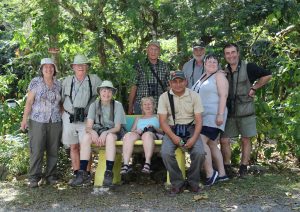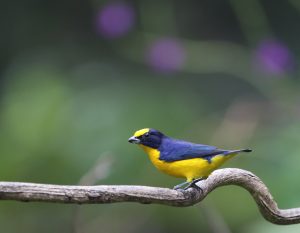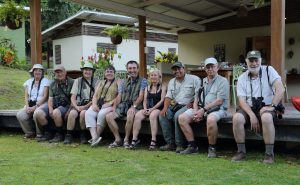So here we are at the Canopy Lodge, in a wonderful setting beside a clear-flowing stream, in a steep-sided verdant forested valley, with perfect weather, in contrast to the freezing cold back home. Bird tables beside the lodge, laden with exotic fruits, attract a variety of equally exotic and colourful birds like Flame-rumped, Crimson-backed and White-shouldered Tanagers, Thick-billed and Tawny-capped Euphonias, Buff-throated Saltator and Clay-coloured Thrush, as well as Red-tailed Squirrels, eager to leg it with bananas under their arms! Meanwhile the adjacent shrubs are alive with small birds such as Snowy-bellied and Rufous-tailed Hummingbirds, Social Flycatchers and Bay-breasted and Yellow Warblers, while noisy Blue-headed Parrots fly across the valley high above. As we cross the bridge that connects the lodge terrace with the outside world, a Central American Agouti, a sizeable frugivorous rodent, paddles across the cascading stream below us. Following our guide Tino, whistling an impressive repertoire of bird calls along the nearby trail, we soon bump into a very approachable Rufous Motmot, with a long blue tail, followed by close views of Fasciated Antshrike, Bananaquit, a tail-swishing Buff-rumped Warbler, the aptly named Orange-billed Sparrow, a male Red-crowned Ant-Tanager flashing a vivid red crown, and more Agoutis. Out on the bumpy minor road, new birds come thick and fast, including Bay-headed Tanager, Tennessee and Rufous-capped Warblers, Olive-striped Flycatcher, smart Black-chested Jays, a Plain Xenops at five paces, a pair of noisy Boat-billed Flycatchers and a trio of Grey-headed Chachalacas. Just up the road, a wobbly bridge joins an undulating trail to a cascading waterfall, and an incredibly well hidden roosting Mottled Owl. So, not a bad start at all.
We begin the new day with an early breakfast, and set off at 6am on a steep winding road down to the Pacific coast, where the first new bird is a Yellow-headed Caracara, strutting along the middle of the road like a catwalk model. The first of many roadside stops in these dry scrubby ranchlands yields Eastern Meadowlarks and a male Giant Cowbird displaying to his smaller mate, whereupon subsequent stops produce a constant stream of new birds including American Kestrel, a pair of Tropical Mockingbirds, a party of Groove-billed Anis, and a Palm Tanager in a palm tree, plus the following kaleidoscopic selection; Blue-grey Tanager, Red-crowned Woodpecker, Ruddy Ground-Dove, Yellow-green Vireo, Ruddy-breasted Seedeater, White-tipped Dove and Yellow-crowned Euphonia, while occasional Wood Storks add variety to the numerous Black and Turkey Vultures soaring in the blue sky. Other notable sightings include a pair of Barred Antshrikes, with punk-style hairdos, a very obliging Panama Flycatcher, posing for the cameras, and super views of one of today’s target birds, a male Veraguan Mango, a rare hummingbird, with a glistening blue throat and dazzling green upperparts. By mid morning, we reach a large expanse of rice fields being harvested by two combines. As the massive ‘beasts’ trundle their way across the crop, hundreds and hundreds of Cattle Egrets and a few Great White Egrets follow their trail like gulls behind a tractor back home, and the melee also attracts an assortment of other speculative predators like Savanna Hawk, Common Black-Hawk, Lesser Yellow-headed Vulture, Crested and Yellow-headed Caracaras, a couple of aerobatic Peregrines, several White Ibises and numerous Great-tailed Grackles, producing a spectacular show. Nearby, small ponds also add white immature Little Blue Herons, Wattled Jacana, Southern Lapwing and Spotted Sandpiper to the growing list, while a brief stop in a small wooded area also adds Scrub Greenlet, Northern Scrub-Flycatcher, White-winged Becard and Straight-billed Woodcreeper. Every stop produces new sightings and we end the morning at the coast where the shorebirds include Brown Pelican, Neotropic Cormorant, Laughing Gull, Royal Tern, Sanderling, Whimbrel, Willet, looking like a cross between a Redshank and a Black-tailed Godwit, and loads of Magnificent Frigatebirds. After a lovely lunch by the beach and a swim in the sea, we restart in the beach house garden with good views of Squirrel Cuckoo, Red-legged Honeycreeper and Common Tody-Flycatcher. Moving on, Tino works really hard to find the resident Ferruginous Pygmy-Owl, which eventually shows fantastically well in the scope, and we end a really productive day with Streaked Saltator and displaying Crested Oropendolas.
We begin the new day with a Green Kingfisher sitting beside the stream right outside the lodge. It’s cool and cloudy as we set off on a short drive to the nearby continental divide between the Pacific and Caribbean slopes. En route, a brief stop at a viewpoint produces Scarlet-thighed Dacnis, Plain-coloured Tanager, Shiny Cowbird, soaring Red-tailed and Broad-winged Hawks, a posing Roadside Hawk, and a group of Blue-headed Parrots. A little further on we follow a trail straddling the continental divide, spotting Yellow-faced Grassquit, White-lined Tanager, Bay Wren and Chestnut-headed Oropendola right at the start. With Buff-throated Saltator and Silver-throated Tanager in the same tree, we soon seem to be finding a new bird every few minutes, such as Paltry Tyrannulet, Chestnut-capped Brush-Finch, Black-and-white Warbler, Bronze-tailed Plumeleteer, Broad-billed Motmot, Thick-billed Seed-Finch, Hepatic Tanager, Northern Emerald Toucanet, and a handsome male Orange-bellied Trogon posing for photos right beside the track, whereas we have to work harder to pinpoint a Wedge-tailed Grass-Finch keeping a low profile in the long grass blowing in the wind at the top end of the trail. On the way back, we find a massive Green Iguana ‘out on a limb’, dangling precariously on the slenderest of twigs. Back on the dusty road, the wires are lined with Grey-breasted Martins and considerably smaller Blue-and-white Swallows.
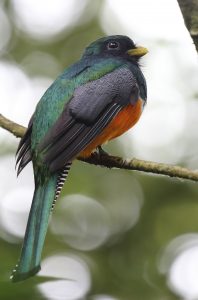
We restart after lunch with a White-necked Jacobin from the lodge terrace. We are soon on a ‘mission’, trying to step quietly through thick crunchy leaf litter as we follow Tino deeper into the woods on the edge of the nearby village. He pauses, makes one of his many calls, and we are soon watching a superb male Lance-tailed Manakin as it flits to and fro at eye level. Incredibly, a pair of magnificent Spectacled Owls are roosting high in the canopy above the same spot, in the opposite direction to the Manakin! In the scope, they look down on us with an air of superiority, with their white eyebrows, stern looking yellow eyes, stiff white bristles around their ivory bills, and lethal talons. So, that’s a different owl each day so far! As well as all the birds, there are plenty of wonderful butterflies, like the Crimson-patched Longwing, the large Rusty-tipped Page and the Sky Blue Hairstreak, with an exact copy of its head at the tail end of the wings, to cleverly distract potential predators; nature is incredible. Our next find is a large Hoffmann’s Two-toed Sloth, having a good scratch through its long shaggy blonde fur, but we have to be quick with the cameras as it doesn’t hang around for long! Strolling on, a Rufous-breasted Wren shows well in the scope, and a Short-tailed Hawk cruises on the updraughts below the ridge, while a Lineated Woodpecker with a garish bright red ‘Mohican’ also shows well while clinging to a dead tree stump. By late afternoon we are still finding new birds such as Lesser Goldfinch and a stunning Lesson’s Motmot, which makes a nice end to another very productive day.
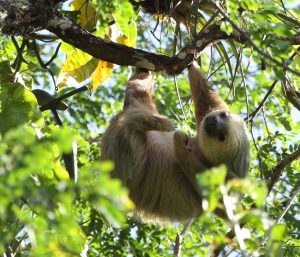
With three owls in the last three days, we set Tino the task of finding another new one today, and within two minutes of leaving the lodge we have a pair of roosting Tropical Screech-Owls in the scope!; amazing. A short way up the road, a fruiting tree is covered with ripe pink ‘berries’, and an hour flies by watching the frenzy of activity including Grey-headed Chachalaca, Rufous Motmot, Clay-coloured Thrush, Cocoa Woodcreeper, Buff-throated Saltator, a delightful little male White-ruffed Manakin, Thick-billed and Tawny-capped Euphonias, Crimson-backed, Bay-headed, Silver-throated and noisy Dusky-faced Tanagers, a couple of Northern Emerald Toucanets, several Spot-crowned Barbets and at least half a dozen Collared Aracaris! Higher up the road, the cool forest is shrouded in low cloud making sightings more tricky, but we still manage to find Lesser Greenlet, Mourning Warbler and a dazzling male Violet-crowned Woodnymph. As the swirling cloud lifts, we connect with a passing mixed flock including Spotted Woodcreeper, Chestnut-backed Antbird, Plain and Spot-crowned Antvireos and Red-crowned Ant-Tanager, plus Bay-breasted, Chestnut-sided, Rufous-capped, Black-and-white, Canada and stunning Golden-winged Warblers! Once the birds move on we switch our attention to a Brown-throated Three-toed Sloth, with a coat like Shredded Wheat, munching its way slowly through a Cecropia fruit, giving everyone plenty of time to grab some shots! After a break for elevenses by the van, another fruiting tree allows great views of Wedge-billed Woodcreeper and Tawny-crested Tanagers, with bright orange crowns, and we end another action-packed morning with Yellow-bellied Elaenia, Golden-hooded Tanager, another Lineated Woodpecker and a lively flock of tiny Yellow-faced Grassquits.

Remarkably, we begin the afternoon with another roosting Tropical Screech-Owl, this time a rufous morph, from the lodge car park! At the Watercress Trail, Dusky-capped Flycatcher is new for the trip, but everywhere is strangely quiet, perhaps due to the strong wind blowing through the canopy, and it’s late afternoon before we find anything else; Stripe-throated Hermit, White-vented Plumeleteer, a pair of musical Rosy Thrush-Tanagers (the male’s breast is deep pink and the female’s is a dark orange) and finally a fabulous little Bat Falcon, looking very alert on its high perch, and a strong candidate for Bird of the Day.
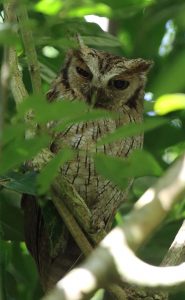
Today’s first bird is a Louisiana Waterthrush along the stream beside the lodge, while the Screech-Owl is on its usual perch by the car park. After a short drive, we park below a tall tree full of Chestnut-headed Oropendolas displaying around their long pendulous weaver bird-like woven nests, with a nearby male Blue-black Grassquit showing nicely too. Along the trail here new birds include Masked Tityra, Rufous-and-white Wren, Grey-capped Flycatcher, Yellow-backed Oriole and White-bellied Antbird, with another Bat Falcon back at the van, but this time zooming around. We still need the elusive Tody Motmot, so Tino takes us to another nearby spot where new birds include Southern Rough-winged Swallow, Southern Beardless-Tyrannulet, and Long-billed Starthroat (hummer number ten). We line up alongside a small stream beside the road, where Tino does a little ‘gardening’ to clear a ‘window’ into the eye level foliage across the stream. The stage is set, and Tino deftly produces a repetitive low guttural call, hoping to draw in the target bird. He soon gets a reply and aims his laser light in the bird’s direction, sitting silently and motionless on a low branch, so that we can actually get this small Motmot in the scope! That’s another fabulous result.
This afternoon, we drive a little further to explore Cerro Gaital, a protected area of thickly wooded mountains, where new birds include Chequer-throated Antwren, Sepia-capped Flycatcher, Scale-crested Pygmy-Tyrant, the tiny White-throated Spadebill, and amazing scope views of an iridescent Green Hermit, calling with its long curved bill, over thirty yards away in the dense foliage!
So, here we are at last, at the world famous Canopy Tower, an old US Army radar tower lovingly transformed into the ideal birding base, a bizarre green metal structure with a huge yellow dome on top, standing proud of the forest canopy with magnificent panoramic vistas of Soberania National Park and photo-opportunities of the surrounding wildlife. Our first lunch here is interrupted by a visiting troop of Geoffroy’s Tamarins which must have smelled the food, as they come rushing towards the dining room windows on the third floor, eager for a piece of the action, while we focus on them with our cameras. These smart monkeys have tortoiseshell coats, with rufous collars, white fronts, black faces, shaven heads with a trendy white scalp, long thin tails and needle sharp teeth. After lunch we descend to ground level to check out the sugar feeders, where Long-billed Hermits and White-necked Jacobins are regular visitors. While looking up for a Squirrel Cuckoo, there is a sudden crack, as the branch supporting a Three-toed Sloth snaps, bringing the hapless sloth hurtling to the ground inside the fence around the tower! It’s not every day one comes to face with a sloth lying flat on its back with spread-eagled limbs, and we wonder how much damage it may suffered given the height of its fall. Fortunately sloths are ‘tough cookies’ as it soon ‘comes back to life’, without the need for resuscitation, and, unfazed by its circle of spectators, crawls purposefully towards the fence. As it climbs the fence, we worry about the razor wire along the top, but it carefully picks a way between the coils and leans across to the nearest tree, which it slowly climbs with a ponderous but determined demeanor, while everyone cheers it on its way after a ‘great escape’! Back in the safety of the tree tops the unscathed ‘super sloth’ wraps its arms around a branch and goes to sleep, apparently none the worse for its ordeal; a once in a lifetime experience for us, but maybe not for the sloth! Up on the observation deck of the tower, at eye level with our sleeping ‘super hero’, hundreds of Black and Turkey Vultures drift by on a northward migration, and amongst them we spot a couple of King Vultures.
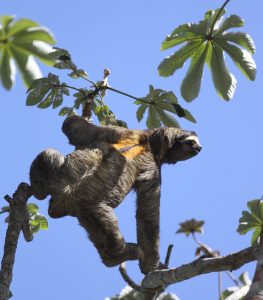
It’s 14th February, so what better way to start Valentine’s Day than up on the observation deck, with a nice cup of tea, just as the sun is rising above the forested hills, with a pair of ‘lovey dovey’ Keel-billed Toucans in the scope? Meanwhile smart male Red-capped Manakins are on the lookout for mates, noisy Red-lored Parrots fly by and other good sightings include Green and Shining Honeycreepers, Tropical Gnatcatcher, Black-headed Tody-Flycatcher, a very obliging Bay-breasted Warbler and Green Shrike-Vireo, with a call like a Greenshank. After breakfast, we stroll down Semaphore Hill Road, a short steep winding road which links the tower with the outside world. Notable sightings here include Violet-bellied Hummingbird, Fasciated Antshrike, Scarlet-rumped Cacique, Ochre-bellied Flycatcher, Purple-crowned Fairy (hummer number fifteen), a male Black-throated Trogon posing in the scope, a tasty Cinnamon Woodpecker with sparkling red eyes, a pair of Dot-winged Antwrens and a Rothschild’s Porcupine, ‘roosting’ in a tree like an owl, but with a prehensile tail wrapped around a branch. It’s now 10.20am and time for mid-morning refreshments delivered from the tower by pickup truck. This is birding in style, and we resume with nice views of Chestnut-backed Antbird, which attracts our attention to a Boa Constrictor, as thick as a man’s arm, but four times as long, with an attractive yellow, black and tan pattern, ideal for blending in with the leaf litter. The butterflies here are also fantastic, like the Thoas Swallowtail and the large blue Common Morpho. More bird sightings follow such as Brown-capped Tyrannulet, Dusky Antbird, Great Tinamou, feeding quietly right next to the road, and a tiny Southern Bentbill at five yards! Here comes our lift back to the tower for lunch.
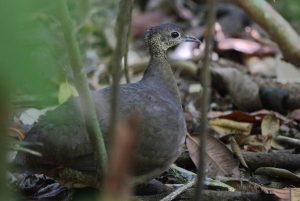
This afternoon we drive alongside the Panama Canal, with massive cargo ships stacked high and wide with containers, and the parallel railway with trains carrying up to eighty containers at a time. The Ammo Ponds here produce a variety of new birds including Green Heron, Rufescent Tiger-Heron, Osprey, Smooth-billed and Greater Anis, Rusty-margined Flycatcher, Mangrove Swallow, Northern Waterthrush, a striking male Baltimore Oriole, and a White-throated Crake skulking in the damp vegetation, while an Isthmian Wren sings right out in front of us.
Today we visit the famous Pipeline Road, a bumpy dirt track through the forest of Soberania National Park, near the canal, where early sightings include Blue Dacnis, Dusky Antbird, Collared Aracari, Black-tailed Trogon, graceful Lesser Swallow-tailed Swifts and the aptly named Black-capped Pygmy-Tyrant, just 2.5 inches long! Tino scores again, this time with a Great Potoo in the scope, roosting high on a branch, followed by a male Black-crowned (aka Western Slaty) Antshrike, and a Brownish Twistwing adding dead leaves to its hanging nest. After elevenses from the support vehicle at 9.20am, we find another Great Tinamou quietly feeding near the track, shortly followed by a noisy ‘mob-handed’ feeding frenzy, whipped up by millions of Army Ants on the march. As the swarm of ants races along tree buttresses, fallen branches and through the leaf litter, it scatters all the other insects in its path, attracting an amazing variety of small birds, including a horde of trilling Bicoloured Antbirds, so intent on catching prey that they ignore us, while busily perching and pouncing, virtually at arm’s length! Other members of the ‘mob’ include Grey-headed Tanager, Red-throated Ant-Tanager, Chequer-throated Antwren, Whooping Motmot, Plain-brown, Cocoa, Northern Barred and Black-striped Woodcreepers, plus Spotted and Ocellated Antbirds. After well over an hour of this memorable spectacle, we leave the birds to their feast and move on to marvel at the incredible dazzling blue Morpho butterflies, while further new bird sightings include White-tailed Trogon and Black-cheeked Woodpecker. After a very nice picnic lunch, beside a long trail of busy Leafcutter Ants, further exploration of the ‘road’ reveals a band of Song Wrens burrowing under the leaf litter, a beautiful large blue-winged Damselfly called the Helicopter Dancer, a cute little Golden-crowned Spadebill in the scope, a tennis ball-sized male Blue-crowned Manakin, posing on a branch at five yards range, and a Northern Tamandua, an arboreal anteater, tearing into dead wood and mopping up termites right beside the track! Next we have a Black-faced Antthrush strutting around with a cocked tail like a Water Rail, followed by Slaty-tailed Trogon, our third one today, a bulbous White-necked Puffbird and a super male Blue Cotinga. Try picking a star bird out of that lot!
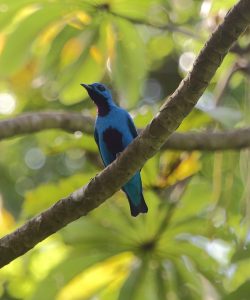
There’s no need for an alarm clock this morning as the blood-curdling calls of Howler Monkeys lead the dawn chorus at 5.40am. We are out on deck by 6.30, in time for a cup of tea, sunrise, and the usual pair of Keel-billed Toucans, along with Scaled Pigeon, noisy Mealy and Red-lored Parrots, a passing Crane Hawk and the best views yet of Green Shrike-Vireo, while a passing ship sails through the tree tops, along the nearby Panama Canal! After breakfast, we follow the Plantation Trail through a forest of towering giants, where early birds include Olivaceous Flatbill and White-flanked Antwren, plus Cocoa, Plain-brown and Olivaceous Woodcreepers. A White-whiskered Puffbird, with speckled plumage reminiscent of a juvenile Robin, and a vociferous White-breasted Wood-Wren also show well here, while a Grey-headed Kite doesn’t linger in the scope for long. There are plenty more fabulous butterflies along the trail such as the Togarna Hairstreak, which also has a decoy head at the tail end, and on the way back, we spot Purple-throated Fruitcrow, a group of White-nosed Coatis and a very obliging pair of photogenic Black-throated Trogons.
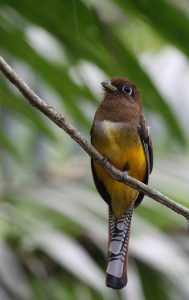
After lunch back at the tower, we visit the nearby Summit Garden, where Blue-black Grosbeak is the first of many new sightings, along with some old favourites like Northern Waterthrush, Black-tailed Trogon, Tropical Gnatcatcher, Streaked Flycatcher, Orange-chinned Parakeet, Masked Tityra, Snowy-bellied Hummingbird, Short-tailed Swift and Golden-hooded Tanager, plus cracking scope views of a glittering male Violet-bellied Hummingbird, providing fantastic photo-opportunities, and a strong contender for Bird of the Day, even trumping the Blue Cotinga! On top of all this, new birds show really well like Yellow-margined and Piratic Flycatchers, Tropical Parula, Summer Tanager, Fulvous-vented Euphonia, Yellow-crowned Tyrannulet, Golden-fronted Greenlet, Black-throated Mango (hummer number sixteen) and Gartered Trogon (our sixth Trogon of the trip). Not bad for a ‘walk in the park’.
This morning we visit Gamboa on the Chagres river, where new birds include Purple Gallinule, Lesser Kiskadee, Buff-breasted Wren and Orchard Oriole, in the same tree as Baltimore Oriole, along with Social and Rusty-margined Flycatchers. Other notable sightings here include plenty of Common Gallinules and Wattled Jacanas, plus Little Blue Heron, Osprey, Mangrove Swallow, Purple-crowned Fairy, Pale-vented Pigeon, Tropical Mockingbird, Red-capped Manakin, White-tailed Trogon, Yellow-crowned Tyrannulet, Common Tody-Flycatcher and Spotted Sandpiper, in immaculate winter plumage. Not only does Tino know all the birds by sight and sound, as well as the butterflies, but he has an amazing ability to find things even when they are well concealed, like a Common Potoo, fast asleep in the scope and yet looking just like a dead tree stump high up in the branches. We follow this with yet another Three-toed Sloth, great views of Purple Fruitcrows and a constantly active Black-tailed Flycatcher, which would be far better named as a Lemon-rumped Fantail!
We spend the afternoon at the nearby Summit Ponds, where we enjoy spectacular views of a male Black-throated Mango, with a sparkling blue-throat, and find a sunbathing Anhinga as well as Green and Striated Herons and an individual resembling a hybrid between the two. We also spot a Boat-billed Heron on a well hidden nest, followed by a Solitary Sandpiper, plus Forest Elaenia, Fulvous-vented Euphonia, Whooping Motmot, Plain-coloured Tanager, Cocoa Woodcreeper, Collared Aracari and a pair of Lineated Woodpeckers; not a bad tally for a ‘quiet afternoon’. PS Back at the tower, Albert invites me into the shower to catch and release a trapped Long-billed Hermit!
It’s sadly time to say many thanks and farewell to our remarkable guide Tino as we leave the tower early this morning and head east for Darién Camp, with our new guide Domi. On the way, a brief stop at Bayano Lake produces another Bat Falcon, sitting on top of the road bridge across an arm of the lake, along with Yellow-green Vireo, Scrub Greenlet, Baltimore Oriole, fantastic views of a male Black-tailed Trogon, and a Streaked Saltator feeding tiny chicks in a nest, while a Pied Water-Tyrant down by the lake is new for the trip. Back on the road we stop again at Torti, this time for refreshments while watching five different hummingbirds visiting sugar feeders beside the restaurant; Rufous-tailed, Sapphire-throated, Snowy-bellied, Scaly-breasted and Black-throated Mango. We pre-order lunch and stroll along the river on the edge of Torti where Black Antshrike, a vivid yellow Prothonotary Warbler, and a Pacific Antwren, preening in the scope, are all new for the trip. After lunch we continue our journey along the Pan-American Highway into Darién province which borders Colombia, where journey’s end is Darién Camp, with just eight safari-style tents, each with a wooden deck backing onto thick rainforest, with Chestnut-headed Oropendolas bubbling overhead and a wonderful selection of spectacular hummers in the ‘garden’ including gems like Violet-bellied, Blue-chested and Sapphire-throated Hummingbirds, plus Black-throated Mango, White-necked Jacobin and Blue-throated Goldentail; welcome to ‘paradise’!
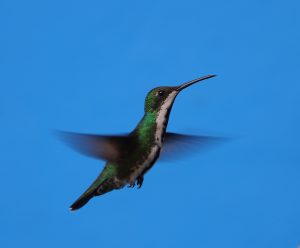
The Howlers sound particularly grumpy first thing this morning and after breakfast, a stroll around camp produces our first Speckled Mourner, followed by a pair of Whooping Motmots, a male Summer Tanager, Lineated and Red-crowned Woodpeckers, Yellow-crowned Euphonia, and five Keel-billed Toucans in the same tree, and looking resplendent in the early morning light. Minutes later we scope a pair of Roadside Hawks calling noisily from a nearby tree top. White-bellied Antbird is also new for the trip, followed by another Two-toed Sloth and our best view yet of a Howler Monkey. Further new sightings include a very close Pale-bellied Hermit, along with Sooty-headed Tyrannulet and White-eared Conebill. After a break for refreshments back at camp, we follow a trail deeper into the forest and soon encounter a lekking area where several smart male Golden-collared Manakins put on a spectacular show with their explosive firecracker-like wing-snapping sounds, which become particularly lively whenever a female shows up. A little further along the trail we have an equally smart Golden-headed Manakin in the scope, and then a Yellow-throated or Chestnut-mandibled Toucan.
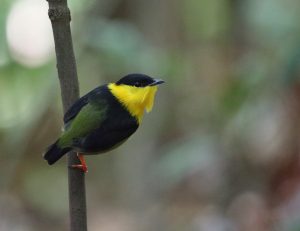
This afternoon, on a track just off the Pan-Am Highway, not far from camp, we start with another Streaked Flycatcher, and then a pair of gorgeous Rufous-tailed Jacamars with long needle-sharp bills, which are new for the trip. Our next sightings include a male Rose-breasted Grosbeak and a very aptly named male Black Antshrike, which looks exactly like it says on the tin. Further sightings include Blue Dacnis, a pair of Spot-crowned Barbets, and best of all a succession of brilliantly coloured Orioles; Yellow-tailed, Orange-crowned and Baltimore, all showing really well; another fantastic day.
Today is ‘Operation Harpy Eagle’, starting with breakfast at 4.30am and then a half hour drive to Yaviza at the very end of the Pan-Am Highway. Yaviza is a small port on the Rio Chucunaque, where we board a small boat, in the style of a dugout canoe, and motor downstream, catching a Lesser Nighthawk in our torchlight as it flaps slowly over the river. As the daylight strengthens, more birds come into view such as Great, Cattle and Snowy Egrets, Yellow-crowned Night-Heron, Little Blue and Cocoi Herons, Neotropic Cormorant, White Ibis, Spotted Sandpiper and Ringed Kingfisher. The boat drops us at 6.40am, a little after sunrise, at El Real de Santa Maria. Santa Maria is a small ramshackle frontier settlement, inaccessible by road, where we pile into the back of a couple of battered old trucks, for a bone-shaking drive into the forest, spotting Laughing Falcon, Roadside Hawk, graceful Swallow-tailed Kites and exotic Black Oropendolas along the way, but best of all is a King Vulture amongst a large gathering of roosting Black Vultures, and in the scope, we can clearly see its red and black head with a strange bulbous yellow wattle dangling over its beak. After an hour or so, the trucks drop us at the start of a forest trail with a rustic sign saying Darién National Park 3km, where a small group of local guides-cum-porters are waiting to lead us into the forest. The trail crosses several small streams amid a forest of awesome trees, with huge buttresses, towering so high that their tops are hidden by the canopy. At 8.50am, we stop for ‘elevenses’, beside a shallow clear river teeming with small fish, before starting the final ‘push’, across the river, up a slope and quickly through a swarm of Army Ants, as if walking barefoot over hot coals! The trail gets narrower and narrower and peters out as we follow the local team ‘off piste’, and at 9.45am precisely, Domi points upward. “Oh my God”, there it is, an enormous white bird with a bulging crested head and two large stereoscopic eyes, staring down at us as it moves its head from side to side, as if sizing us up for a strike. It looks positively regal on its lofty perch, and in the scope, the lethal talons look as long as human fingers! It has taken this spectacular bird 25 months to grow to full size, measuring 38 inches from head to tail! No wonder there are the remains of a freshly caught adult sloth festering on the ground below the eagle’s tree. Forty five minutes, and hundreds of photographs later, we retrace our tracks through the forest, back to the river for a well-earned picnic lunch, with a Crimson-crested Woodpecker peering bemusedly out of its nest hole along the way. Straight after lunch, Domi pinpoints a male Yellow-backed Tanager way up in the canopy and then scopes an incredibly well hidden Slaty-backed Forest-Falcon. A pair of White-whiskered Puffbirds, and more fabulous scope views of the King Vulture, round off the afternoon before we catch the boat back to the highway; mission accomplished!
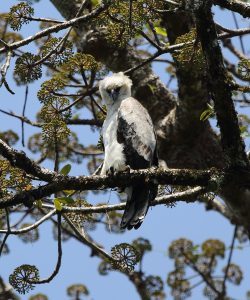
This morning we bird the dirt road leading to the shanty settlement of Las Lajas and beyond, across a makeshift bridge made of thick logs and soil! Cinnamon Becard is our first bird, followed by Forest Elaenia, a pair of Blue Dacnises, Great Crested Flycatcher, Capped Heron, Streak-headed Woodcreeper, a male Black-crowned Tityra, Plain Xenops, Yellow-margined Flycatcher, Lesser Kiskadee, another smart Prothonatory Warbler, a soaring Great Black-Hawk and a sequence of woodpeckers, starting with the tiny Olivaceous Piculet, plus Red-crowned, Red-rumped, Black-cheeked, Crimson-crested, and a striking male Golden-green Woodpecker, with a vivid red crest, black face mask, red moustache and bright yellow throat; one of the most beautiful woodpeckers I have ever seen.
After lunch and some ‘r & r’ back at camp, a different dirt road produces a few of the usual suspects, as well as a pair of Pied Puffbirds, approachable Long-tailed Tyrants, and eventually, after a lot of neck-breaking work, a pair of Double-banded Greytails, with a chattering song reminiscent of a fishing reel. We end the afternoon with a very obliging Streaked Flycatcher, and a group of fearsome-sounding Howler Monkeys, but when we scope one of the males, with perilously pendulous testicles hanging down like two large yellow plums in a mesh bag, the reason for his ill-mannered sounding howls becomes apparent!
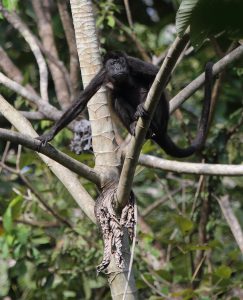
After a very short drive along the highway, a four wheel drive truck takes us on a slow bumpy off road ‘crawl’, past a small pond with Wattled Jacanas, Green Heron, a Solitary Sandpiper, our first Limpkin of the trip and some miniature Spectacled Caiman. Further on, we find Southern Beardless-Tyrannulet, Red-rumped Woodpecker and a Laughing Falcon, on a branch with a four foot long headless snake hanging from its talons. Ironically, our next sighting is a slender six foot long Bird-eating Snake, right alongside the truck! At the end of the track, we park at the boundary of a protected area and set off on foot into the tranquil forest along a small burbling stream with good views of a male White-flanked Antwren and Wedge-billed Woodcreeper, while Yellow-throated Toucans call from the canopy high above and amazing large Blue Morpho butterflies glide through the trees just above our heads. Other insects attracted to the water include Orange Daggerwing butterflies and Uranias; large black and emerald day-flying moths. Suddenly, a Spectacled Owl lands on an open corkscrew vine right above us, giving spectacular views and photo-opportunities, as it stares down at us with its big yellow eyes, through white ‘spectacles’; awesome! A pair of Panamanian Night Monkeys sleeping in an open tree hole are far harder to pinpoint in the scope, and from the same spot we scope the hammerhead profile of a Royal Flycatcher, while a Purple-crowned Fairy ‘dances’ above the stream; what a magical place. Other top sightings here include White-tailed Trogon, Golden-headed Manakin, a White Hawk perched on a branch and incredible views of a Black-crowned Antpitta, out in the open on top of a log!

The Panamanian Night Monkey does exactly what it says on the tin. It’s a monkey that lives in Panama and comes out at night, and this afternoon we visit a known ‘hideout’ where we soon have one of these strange nocturnal primates in the scope, sleeping with its face poking out of a tree hole, and occasionally opening its large brown eyes, before snoozing again. Moving on to the not so wet Yaviza wetlands, we begin with great views of a pair of aptly named Spot-breasted Woodpeckers, almost rivaling yesterday’s Golden-green for beauty, while a small pool has a Wattled Jacana with two tiny big-footed chicks. Other specialities here include Red-breasted Blackbird, Yellow-tailed Oriole and a pair of striking Black-capped Donacobiuses, along with six Howler Monkeys and yet another Three-toed Sloth in the tree tops, while a trio of Great Green Macaws flies by at sunset, ending a day with lots of memorable sightings.

This morning we explore the dirt road to Nueva Vijia, birding safari-style from the back of an open pickup truck, starting with Lineated Woodpecker and Spot-crowned Barbet, a pair of Cinnamon Woodpeckers, Yellow-rumped Cacique, and a Wood Stork in a tree, with stops for scoping special birds like Grey-lined Hawk and another Great Potoo ‘glued’ to the end of a broken branch. Every few minutes, another good sighting pops up in great light, including White-necked Puffbird, Baltimore Oriole, a glorious male Black-tailed Trogon, with a red eye ring, yellow bill, emerald breast and strawberry-red belly, standing out against the verdant foliage. A little further on, a posing Roadside Hawk and then two long-legged Crane Hawks provide photo-opportunities, while a pair of Golden-green Woodpeckers proves more of a challenge. The female is a gorgeous blue-eyed blonde, and a real film star but camera shy. Celebrities continue to appear, such as Long-tailed Tyrant, Dusky-backed Jacamar, Yellow-bellied Flycatcher, Golden-hooded Tanager and a Red-billed Scythebill, with a ridiculously oversized bill, and it’s still only 9am! A Plumbeous Kite circles overhead, a pair of Pied Puffbirds show well, along with ‘just another Crane Hawk’. From the village we follow a trail into the forest and quickly pick up Grey-cheeked Nunlet, Black-crowned Antshrike, and eventually, Black-bellied Wren, our tenth wren of the trip! More nice views of Purple-throated Fruitcrows follow, along with another massive male Black Oropendola. At the end of the trail is a pool boiling with frogs, fish and small Caiman, and there is so much to see it is hard to know where to look first. Options include Green Ibis, Green, Cocoi and Boat-billed Herons, American Pygmy and Green-and-rufous Kingfishers, Purple-crowned Fairy, Red-billed Scythebill, Royal and Black-tailed Flycatchers and Lesser Kiskadee, but star of the show must surely be a sinuous-necked Agami Heron.
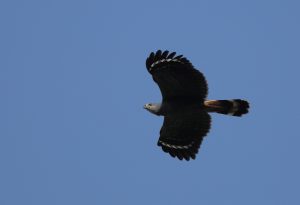
This afternoon, we return to the Yaviza wetlands, hoping for better views of the Great Green Macaws, but they remain tantalisingly distant, so we have to make do with the usual cast, along with plum views of Blue-headed Parrots and a pair of Striped Cuckoos, erecting impressive crests each time they call, followed by Common Pauraques resting along the track straight ahead of the vehicle on the drive back to camp at dusk.
It’s our last day in Panama, with time for a visit to the private San Francisco nature reserve on the way back to Panama City, where we enjoy close views of a pair of Green Kingfishers, while still finding new birds like Black-breasted Puffbird, Choco Sirystes, White-ringed Flycatcher and a pair of lovely little Blue Ground-Doves. By now we had seen over 330 bird species, including six species of Trogon, nine species of Woodpecker, ten different Wrens, sixteen Tanagers and eighteen different Hummingbirds, along with some memorable experiences, like the ‘flying super sloth’s great escape’, the Army Ant swarm feeding frenzy, the spectacular Spectacled Owl, staring down at us, so many exotic and colourful butterflies and birds, and of course, the majestic Harpy Eagle.

